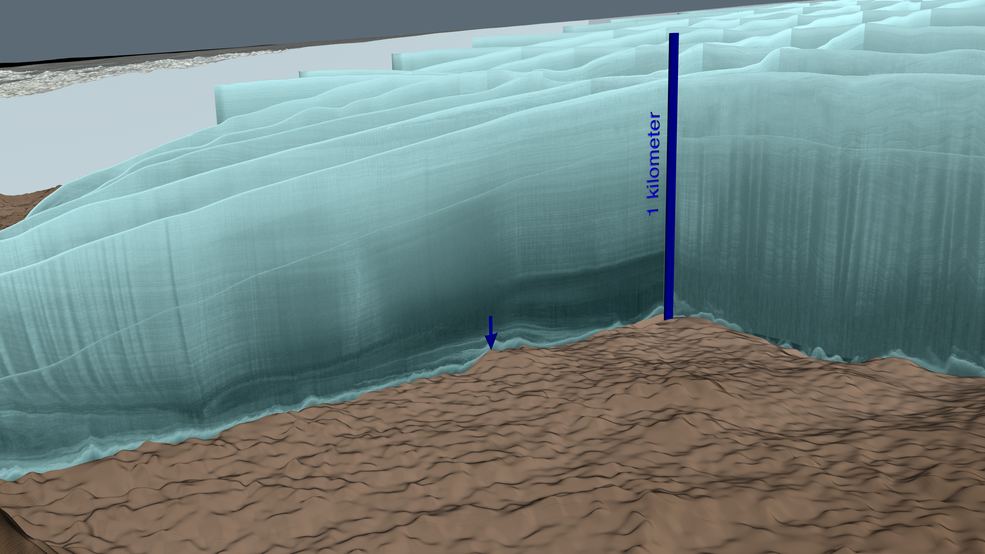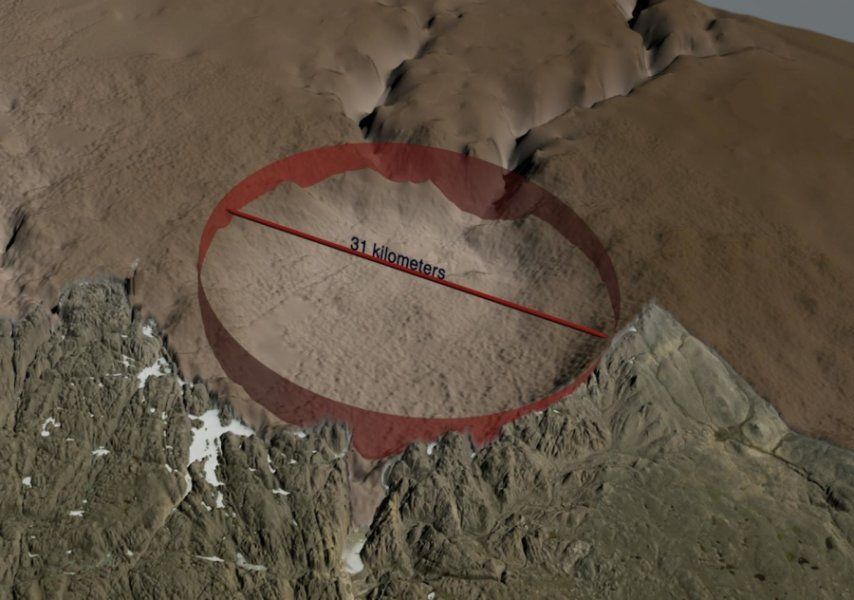An international team of scientists have discovered what lay hidden under Arctic ice for thousands or even hundreds of thousands of years. Using data primarily from NASA’s Operation IceBridge, they discovered one of the 25 largest impact craters anywhere on Earth. And its discovery may re-ignite an old climate debate.
This impact crater is buried under more than a half mile of ice. It was originally spotted by a team of scientist using freely-available data from Operation IceBridge, NASA’s on-going mission to image the planet’s polar ice. The crater’s in northwest Greenland under the Hiawatha glacier, and it’s about 300 meters deep (1,000 ft.) and about 30.5 km (19 miles) in diameter. (For a comparison, the largest crater on Earth is the Vredefort crater, at 160 km. in diameter.)
“The crater is exceptionally well-preserved and that is surprising…” – Professor Kurt Kjaer, lead author of the study.
The discovery was initially made in 2015, but the international team, led by researchers from the University of Copenhagen’s Centre for GeoGenetics at the Natural History Museum of Denmark, has spent 3 years verifying their discovery. The team published their paper in the journal Science Advances on November 14th.
“The survey exceeded all expectations and imaged the depression in stunning detail.” – Joe MacGregor, Glaciologist at Goddard Space Flight Center.
The image below shows two views of the crater. One is of the ice covering the impact crater, the other is the topography of the rock buried under the sheet of ice.
https://gfycat.com/DeadlyOpulentBirdofparadise
The team has NASA’s Operation IceBridge to thank, at least partly, for their discovery. NASA makes all the data from that mission available to anyone who wants it. NASA Glaciologist Joe MacGregor, from the Goddard Space Flight Center, said, “NASA makes the data it collects freely available to scientists and the public all around the world. That set the stage for our Danish colleagues’ ‘Eureka’ moment.”
Initially, the team behind the discovery noticed an enormous circular depression under the ice sheet in ice-penetrating radar data from Operation IceBridge. Then, MacGregor examined the surface ice the region of the Hiawatha Glacier. Using satellite imagery from NASA’s Terra and Aqua satellites, he found evidence of a circular pattern on the surface of the ice that matched the circular depression under the ice.
That wasn’t enough evidence to confirm the discovery. In May 2016 a research plane was dispatched to fly over the Hiawatha Glacier. It’s mission was to use state-of-the-art ice penetrating radar to map the crater and the ice covering it.
MacGregor explained the need for follow up evidence: “Previous radar measurements of Hiawatha Glacier were part of a long-term NASA effort to map Greenland’s changing ice cover,” MacGregor said. “What we really needed to test our hypothesis was a dense and focused radar survey there. The survey exceeded all expectations and imaged the depression in stunning detail: a distinctly circular rim, central uplift, disturbed and undisturbed ice layering, and basal debris — it’s all there.”

The study says the crater was caused by an iron meteorite more than a half mile wide that crashed into Earth less than 3 million years ago. The crater was then covered by the Arctic ice, and a happy accident of preservation. This is unusual, according to Kurt Kjær, a professor at the Center for GeoGenetics at the Natural History Museum of Denmark and lead author of the study. He said, “The crater is exceptionally well-preserved and that is surprising because glacier ice is an incredibly efficient erosive agent that would have quickly removed traces of the impact.”
The team is not certain of the impact date, and that is why the old debate might be revived. Kjaer says that the impact crater may have occurred toward the end of the last ice age. This would make it one of the youngest on Earth.
The Impact Crater and the Younger Dryas
The debate concerns a period of time called the Younger Dryas. It was a 1000 year time period of cooling 12,800 years ago, near the end of the last ice age. At that time, a number of species went extinct. There’s been a debate about what caused it.
About a decade ago, a group of scientists published a study called “Evidence for an extraterrestrial impact 12,900 years ago that contributed to the megafaunal extinctions and the Younger Dryas cooling.” They posited that a meteorite impact triggered the Younger Dryas and the extinctions that went along with it. Other experts were skeptical, and highly critical of the theory. Other published papers flat-out denied that there was a meteorite impact, citing their own evidence.
The debate has simmered since then, but this discovery has the potential to re-ignite it. The idea is that an impact would’ve melted massive amounts of ice, releasing cold water into the oceans and causing a rapid cooling. That rapid cooling would’ve been responsible for wiping out North American megafauna and disrupting the Paleo-Indian culture.
We know that meteorite impacts can have consequences for life on Earth. The dinosaur-killing Chicxulub crater proves that point. But it’s too early to say what the consequences were of this impact. As for the researchers behind this discovery, they’re not done yet. They plan to continue their work in this area, addressing remaining questions on when and how the meteorite impact at Hiawatha Glacier affected the planet.
Sources:
- NASA Press Release: International Team, NASA Make Unexpected Discovery Under Greenland Ice
- Research Paper: A large impact crater beneath Hiawatha Glacier in northwest Greenland
- Research Paper: Evidence for an extraterrestrial impact 12,900 years ago that contributed to the megafaunal extinctions and the Younger Dryas cooling


Great work. When I had viewed the NASA video this week, I recall where a scientist, possibly a geologist was making a case for a sudden and abrupt “Mini Ice Age” as he may have labeled it, where he and others speculated that it could have been caused by an impact in the northern hemisphere some 12,000 +/- years ago. At the core of this gentleman’s research was to explain what ended a small culture of Indian peoples living and flourishing (along with the woolly mammoth) in and around the area west and south of the great lakes, if my memory serves correctly.
As I recall the program was something like and National Geographic or Nova production. (Science or history Channel?) I also recall that he showcased what he called evidence for the event that was located in caves near or around the Kentucky area. The timeline for this report was 7 or 7 years ago and may be as old as 8 to 10 years ago.
I was thinking while the NASA video was playing that I bet we hear of this gentleman and his campaign again, and real soon.
Does anyone recall this guy’s name?
Graham Hancock and Randall Carlson are at the forefront of this epoch, they show real evidence that this caused the erosion around western America (the scablands) and show very interesting details on what may have been to origins of several historical legends such as the great flood. Whilst Universe today only reports on direct evidence, we’ll probably discover that this was the cause. Another reason Nasa’s budget needs to increase, helping us uncover our own origins as well as moving us forward to the stars.